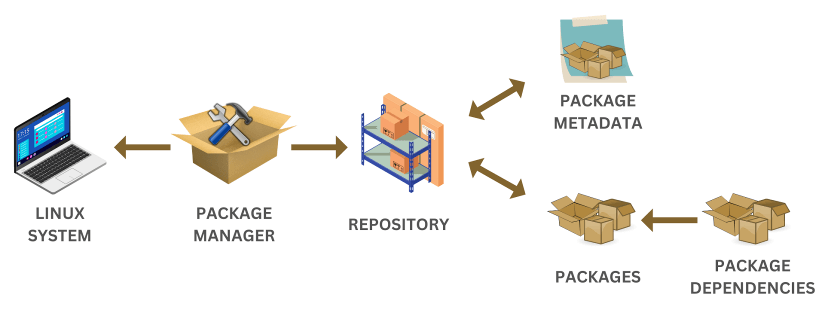What is Package Manager in Linux?[Install, Update & Manage]
A package manager is a utility that simplifies installing, updating and managing software packages on a Linux system. With the help of a package manager in Linux, a user can easily keep all the software on their system updated and compatible with each other.
What is a Package?
In Linux, a package refers to a compressed archive file that contains software along with all necessary libraries, header files, and other files that software needs to run. By utilizing packages, Linux distributions can effectively manage the installation, removal, and updating of software on a system with ease. In Linux, the package manager typically recognizes packages that are distributed in a specific format. Common package formats include .deb (used by Debian and Ubuntu), .rpm (used by Red Hat, CentOS, and Fedora), and .pkg (used by macOS).
What is a Package Manager?
A package manager is a software tool that simplifies installing, updating, configuring and removing software packages on a system. Users commonly use package managers in operating systems such as Linux, macOS, and Windows. There are several package managers available in Linux, such as:
By utilizing a package manager in Linux, managing software becomes effortless since the system automatically downloads and installs updates, ensuring the software remains up-to-date and secured.
What is a Repository?
A package manager uses repositories to search and download software packages in Linux. A repository is a collection of packages just like a warehouse full of goods. Some common repositories with their package managers and servers are mentioned below:
A. Debian and Ubuntu
Package Manager:
APT (Advanced Package Tool)
B. CentOS and Red Hat Enterprise Linux
Package Manager:
YUM (Yellowdog Updater Modified)
C. Arch Linux
Package Manager:
Package Manager:
Package Manager:
How Does the Package Manager Work?
The package manager is not exclusive to Linux, it is almost available in all operating systems. Developers construct and develop software applications and packages on the foundation of the Linux operating system.
The package manager requests a list of software packages that can be installed on the system by connecting to the repositories. It evaluates every package metadata to ensure that its dependencies are satisfied.
The package manager downloads and installs a package and its dependencies if they are not already installed, to fulfill any missing requirements. It continuously checks the repositories for updated versions of installed packages and installs them when necessary.
The package manager eliminates any package that is no longer required from the system. While elimination, the package manager analyzes if any packages depend on it and if so, it prompts the user for further action.
A package manager is capable of performing various other functions.
How to Install Package Manager?
The installation process of the package manager is very easy in Linux. I’ve included the syntax and a practical example for installing a package manager in the following section.
The syntax for installing the package manager is given below:
sudo apt-get install Package_ManagerAs you have seen, there are various packager managers in Linux. Among all the package managers, I will show you how to install the snap package manager. To install the snap package manager you can follow the procedure below:
Steps to Follow:
➊ Initially launch the Terminal in Ubuntu.
➋ Execute the following command in the command prompt:
sudo apt-get install snapd➌ Then, press the ENTER key.
As you can see, the output displays that the package manager is installed.
How to Uninstall Package Manager?
Uninstalling a package manager is a straightforward process in Linux. Below, you’ll find the syntax and a practical example of how to uninstall a package manager.
The syntax for uninstalling the package manager is indicated below:
sudo apt-get remove Package_ManagerAs I have shown you how to install the snap package manager, and that’s why I will show you how to uninstall the same package manager. To uninstall the snap package manager you can follow the procedure below:
Steps to Follow:
➊ To start open the Terminal in Ubuntu.
➋ Run the command below in the command prompt:
➌ Now, hit the ENTER button.
In the following image, the output displays that the package manager is removed.
Advantages of Package Manager
- Installing, updating, and removing software packages become easier using the package manager. The user does not have to manually download and install software packages.
- A package manager can automatically manage dependencies for a software package that ensures the installation and configuration of all the necessary components and libraries appropriately.
- A package manager saves time for the users who would need to look for the software on the internet and manually download and install it as it maintains a streamlined repository of software packages.
- A package manager frequently comes with built-in security features to verify the authenticity and safety of software packages.
- A package manager helps to reduce the risk of software conflicts or compatibility issues which ensures the system has a consistent set of software packages that are compatible with each other.
Disadvantages of Package Manager
- Limited software availability: A user may need to manually download and install the packages as specific programs may not be downloadable or installable through a package manager.
- In some cases, conflicts between dependencies and other software packages can cause difficulties in installation or upgradation.
- Users may experience delays as the latest software versions may not be available immediately in the package manager’s repository.
- Users may not have full control over the software installation process, which can affect where the user installed the software.
- A package can introduce security vulnerabilities to the user’s system if a repository or package is compromised.
Conclusion
In this article, I have explained what a package manager is and how it works in Linux. You’ve also seen the advantages and disadvantages of using the package manager. After completing this article, you will get a basic idea of package manager in Linux.
Similar Readings


